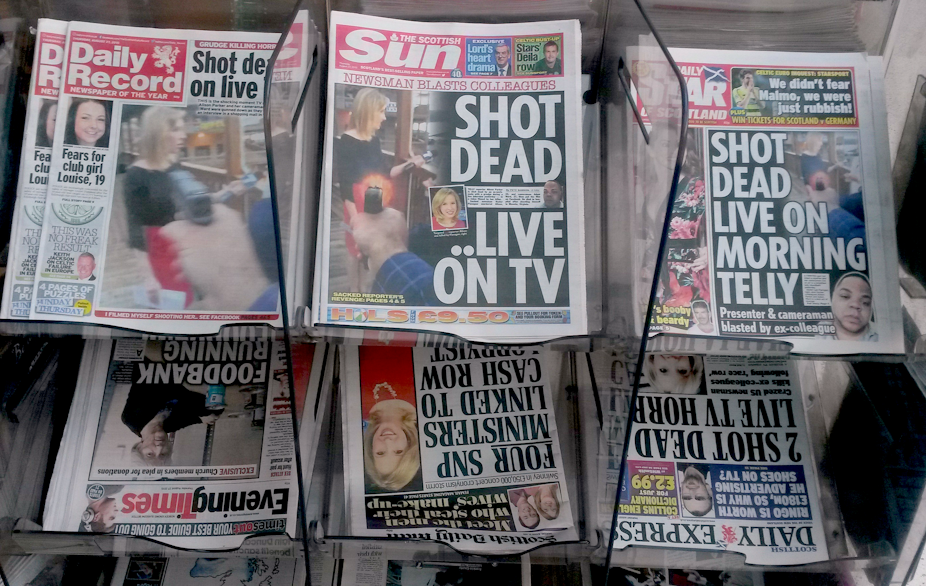The horrific murders of reporter Alison Parker and cameraman Adam Ward live on WDBJ7 TV have, understandably, raised questions about responsible reporting. WDBJ7’s live broadcast, and the video which the killer later posted to social media, have been the focus of the initial debate. In the US the major news channels showed some or all of this footage. In the UK the BBC’s major bulletins showed extracts from both Ward and the killer’s footage, stopping when the shooting began.
Other UK news outlets have been less restrained. The killer’s video could be watched on The Sun and Mirror online, and stills from his video – gun held aloft, Parker oblivious to the threat – adorned the front pages of their print runs, also appearing in The Times, The Telegraph and Daily Mail.
In the reporting of any crime of violence, there is an important balance to be struck. Responsible reporting needs to hold the perpetrator to account. But it should not glorify or legitimate the perpetrator or his actions. The UK coverage has largely got this wrong. And it’s not just about the videos.
Even those outlets which took a more restrained approach to the video have widely repeated the killer’s words from his rambling suicide note and Twitter account. His views on the people he killed have been given vast exposure – as has his own WDBJ7 career, with some news sites carrying links to his “reporter reel”. We can see his face looming large in every news outlet. His name in headlines worldwide. He is known.
Understanding the killer and his motives is important. But the kind of specifics offered in much of the UK coverage go far beyond this to provide a posthumous platform for the killer’s worldview. He is placed in a shooters’ hall of fame, alongside the men who committed mass murders at a church in Charleston, a school in Sandy Hook, a cinema in Aurora, a campus in Virginia …

Entitlement
In their brilliant book on sexual murder, Deborah Cameron and Elizabeth Frazer talk about sexual killing as an act of self-affirmation on the part of the killer, through which a particular kind of male subjectivity is confirmed. A similar argument can be extended to the Virginia murders, as well as to the numerous other crimes of spectacular gun violence in the US. It is a too rarely remarked upon fact that the vast majority of these crimes are committed by men.
When the killers’ motives are explored, the underlying factor is typically a sense of entitlement: to a particular place and space in the world, to the attentions of women, to a particular career, to wealth or media attention. Their motives tell us a lot about how masculinity is constructed in Western cultures. And what it means to aspire to – and fall short of – dominant ideals.

This sense of entitlement is not unique to apparently disenfranchised shooters. It’s there in the accusations against US entertainer Bill Cosby. It’s there in Jimmy Savile’s decades of abuse in the UK, enabled by a culture of celebrity which placed him on a pedestal, made a running joke of his sexism, and was complicit in the devaluation of his victims, both female and male. And it’s there in less newsworthy crimes of domestic abuse which occur across the country, every day of every week.
Focusing on what makes these crimes generic, predictable, typical is one way of puncturing the same aggrandised sense of entitlement which seems to have motivated the Virginia killer. It’s a way of refusing to play his game: to reject his claims that his crimes made him special, memorable.
The hardest question
In reporting the Virginia case, of course journalists need to look at the killer’s suicide note and Twitter account. But they don’t need to repeat them. The job of the reporter should be to interpret his worldview, not represent it; to identify its patterns, not reproduce its specifics.
There is an understandable desire to search the killer’s life and background for clues as to his crimes, and in the days and weeks ahead there will no doubt be much of this. This poses a challenge for any of us writing about perpetrators of mass crimes, whether as journalists or academics. How do we understand, critique or learn from an individual case without contributing to the cult of celebrity?
This isn’t an easy question. It’s one I’ve been grappling with for years. But an important first step is that we recognise the generic characteristics of these crimes – and the way they are represented – and think about our own roles in these stories.
This article is about the media coverage of the murders of Alison Parker and Adam Ward. It isn’t about the killer. There is no need, then, to use his name or his image. This is a deliberate act and it’s one many others have taken. It’s an approach which needs to become more embedded in responses to men’s violence if the media – if all of us – are to be part of the solution and not the problem.

